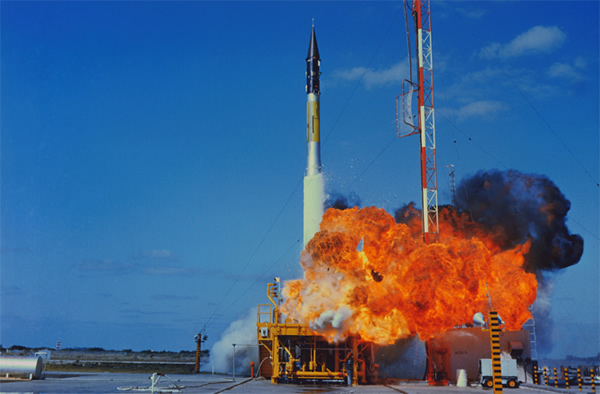Not a Flopnik: When Vanguard Didn't Fail
Flame and smoke burst from the Vanguard test vehicle at Cape Canaveral, Florida, during the first firing of the complete 3-stage rocket.
On Dec. 6, 1957, the Navy’s Vanguard rocket stood on a launch pad at the Cape Canaveral launch site in Florida. The payload atop the rocket was the TV-3 satellite, the one designed to level the playing field between the United States and the Soviet Union; the latter nation had taken the lead in a budding space race by launching the satellite Sputnik two months previously.
Sixteen minutes before noon, Vanguard roared to life. It began lifting off the launch pad, tentatively at first, then seemed to give up. The rocket lost thrust and collapsed as it settled back on the pad. It erupted in flames. The satellite was thrown clear and started sending out its signal for the world to hear. The media had a field day with the failure, dubbing the launch Failnik, Spätnik, Flopnik…
The story of Vanguard usually ends with this failed launch, but the program didn’t end there. Vanguard lived to launch another day, finally finding success four months later.
The Vanguard satellite launches were part of America’s participation in the 1957-58 International Geophysical year, an 18-month long cooperative investigation between international scientists designed to study a period of high solar activity. The American National Security Council had approved the United States’ IGY satellite in 1955, and President Eisenhower chose the US Navy and its Vanguard rocket as the technology behind this satellite program. The idea was to use a civilian sounding rocket rather than a re-purposed missile, keeping space exploration separate from the nation’s weapons development program.
After failing to launch America’s first satellite, there were other Vanguard rockets and satellites ready to fly; canceling a program with existing hardware wasn’t a serious consideration. Each launch had a 50 percent chance of safely delivering its payload into orbit, so it was worth continuing the program to potentially launch multiple satellites.
A second Vanguard launch didn’t fare much better than the first; the satellite failed to reach orbit on Feb. 5, 1958.
The third time was the charm. A Vanguard rocket successfully put the Vanguard 1 satellite in orbit on March 17, 1958.
The spacecraft was, appropriately for the time, fairly small and simple. Vanguard 1 was a 3.24-pound aluminum sphere just under 6.5 inches in diameter. Inside the sphere were two transmitters, one powered by a mercury battery and the other by six square solar cells mounted outside on the satellite’s body. These transmitters primarily provided engineering and tracking data on the satellite, but doubled as a way for scientists to determine the electron content between the Vanguard 1 and ground stations. The satellite also carried two thermistors into orbit designed to gather data on its internal temperature over 16 days, data that helped scientists determine the effectiveness of Vanguard 1’s thermal protection system. These communications between the satellite and Earth were managed by the six roughly foot-long aerials stuck out from the sphere.
The satellite ended up in a 406 by 2,466 mile elliptical orbit. And it’s still orbiting the Earth today though it’s been quiet for decades. Vanguard 1’s batteries died in June of 1958 and its solar-powered transmitter stopped working in May of 1964. And taking into consideration the effects of solar radiation and atmospheric drag on Vanguard 1, the best estimates say it’s orbit won’t decay for another 240 or so years.(Mar 17, 2014 03:25 PM ET // by Amy Shira Teitel)












